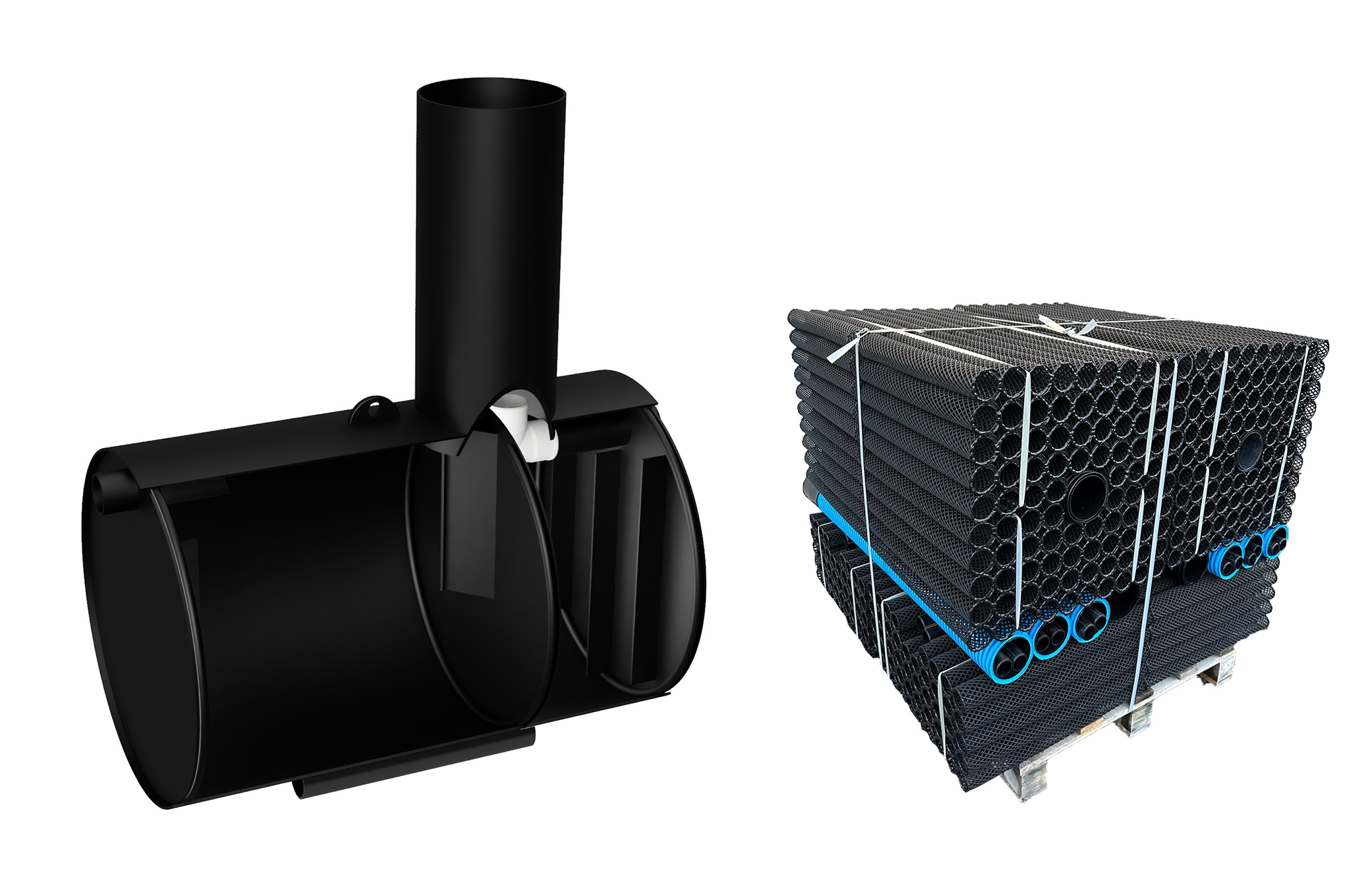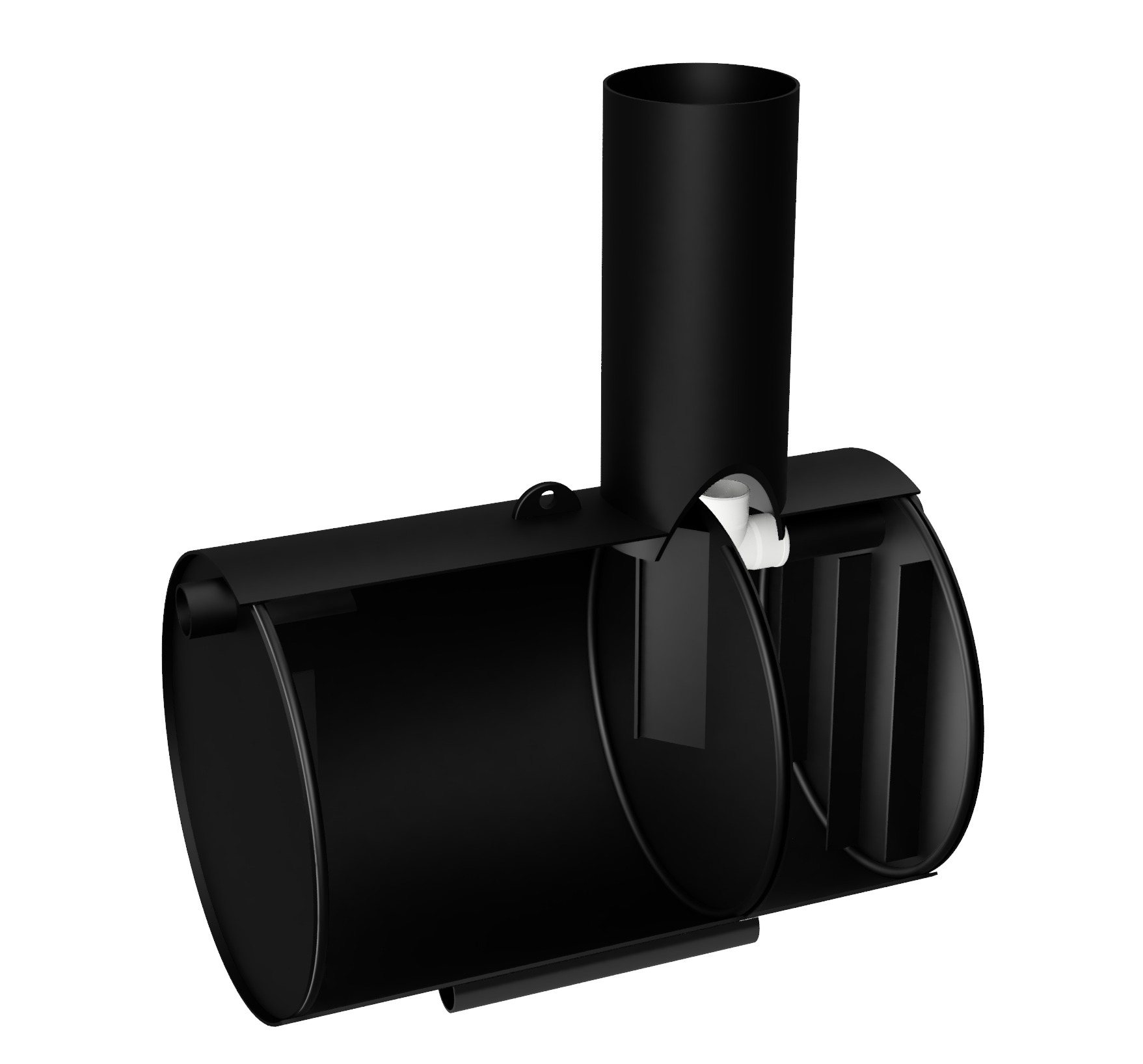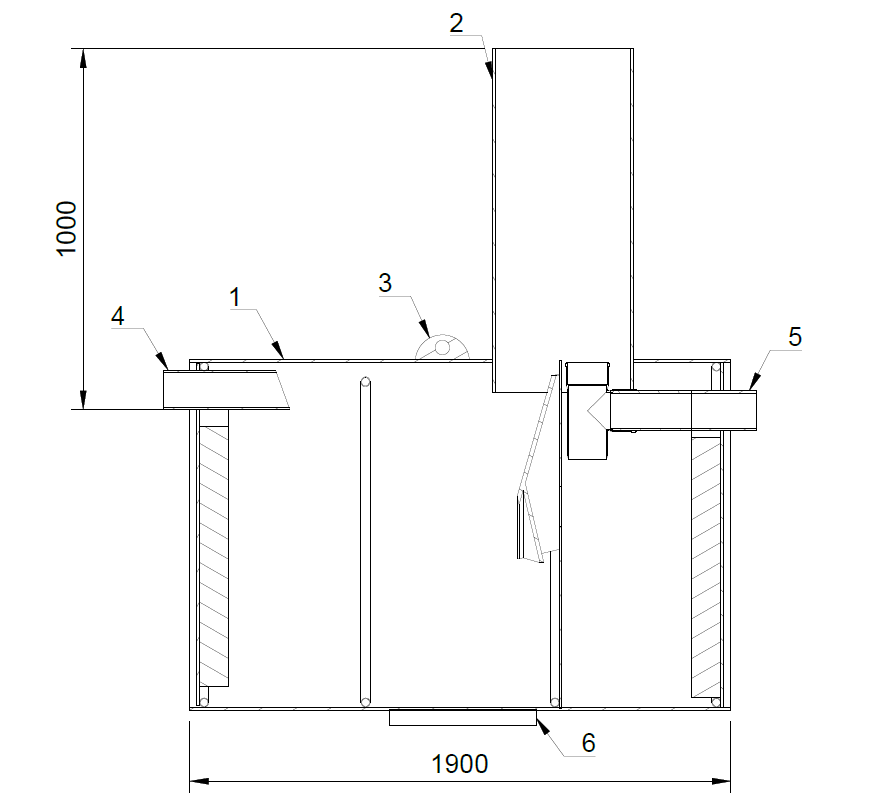Your cart is currently empty!
AC VRT 1200L package with biomodules 14m2
Shipping will be added or pick up from us in Västerås.
2.023,54 €
Shipping will be added, ask for price to your address or pick up from us in Västerås.
Very affordable package of sludge separator and biomodule package 14m2
The package is unique as it includes inspection pipes on the spreader pipe and the new requirement for groundwater pipes.
Package Includes:
1st VRT 1200 sludge separator
6 Biomodules
6m Spreader pipe 110mm 2.5m
1st cleaning cap for spreader pipe
2pcs Ventilation pipe
2pcs Ventilation hood
1st Fiber cloth 20kvm
1st groundwater pipe
If you have a ground bed, supplement with the marble bed package
Virte VRT Sludge separator is a real three-chamber well with separate compartments to ensure good function with slow flow that reduces the risk of sludge escape that clogs the infiltration bed.
The tank is delivered with a cutable neck 1 meter high and a lid.
The round shape makes the tank very strong, but unfortunately it is often not chosen by suppliers, as the shape is expensive to handle in manufacturing and transportation.
The sludge separator is CE marked according to 12566-1
Technical data
Tank volume: 1200 liters
Total water volume: 1000 liters
Diameter: 972mm
Length: 1900mm
Neck diameter: 400 mm
Neck height: 1000 mm (can easily be cut to any height)
Inlet and outlet are 110mm
If you want other dimensions of the tank or greater burial depth, etc. we will solve it on offer.
Lifting eyes are provided on the tank for easy handling during installation.
Material PE plastic
The material of the tank ispolyethylene plastic (PE) which is more resistant to external damage than fiberglass and much more environmentally friendly.
PE plastic offers the following advantages:
- Low density (low weight when handling the tank)
- Good impact resistance even at low temperatures
- Good wear resistance
- Minimal moisture absorption
- Excellent chemical resistance
- High resistance to corrosion
- Best plastics for the environment
- Can be recycled or burned
- Life expectancy of over 100 years
Installation restrictions
Max soil layer above the tank: 900mm
Max burial depth: 2165mm
Maximum level of groundwater around the tank: 500mm
If you want other dimensions of the tank or greater burial depth, etc. we will solve it on offer.
Environment
The tank is made of PE (Polyethylene) plastic which is based on hydrocarbons and is thus suitable for incineration.
PE plastic is very durable and resistant to chemicals, a major advantage is that PE plastic can be recycled.
VIRTE Technologies
The manufacturer VIRTE Technologies has been around for 17 years.
VIRTE develops and manufactures its products in Latvia, buys the highest quality materials from Germany and Austria and exports to more than 10 different countries.
AC biomodules for infiltration & soil bed
The package is unique as it includes inspection pipes on the spreader pipe and the new requirement for groundwater pipes.
A new requirement is that the property owner or supervisory authority must be able to check that the infiltration or ground bed is not in the groundwater, for which the facility needs to have a so-called groundwater pipe included in the package.
Inspection pipe with cap on the spreader pipe makes it possible to flush the spreader pipe in case of sludge escape from the sludge separator and inspect the function.
This package is used if a percolation test gives an LTAR value above 15 and is used for Simple, Enhanced and Reinforced Infiltration.
AC Biomodules are made up of a carrier material that has been used and tested in various types of treatment plants for many years and is used by several suppliers.
A natural biofilm is formed on the tubular carrier material that breaks down the pollutants and nitrogen in the wastewater.
The design of the bio modules means that the bacterial culture living in the bio skin gets optimal oxygenation and the risk of clogging is then much smaller.
No distribution well is needed when using only one spreader line.
Advantages AC Biomodules
- The purification function is optimized by a very good oxygenation in the patented modules.
- The pollutants in the wastewater are broken down by the bio-skin formed in the tubular modules.
- The wastewater is distributed and spread over a much larger area than in an ordinary plant if spreader plates are used.
- The surface area of the bed is reduced by 40% compared to traditional infiltration.
The design of the bed can be changed, as long as the surface area is the same, the length can be halved but then the width must be doubled.
The size of the package is 120x110x140, weight about 100kg
If you switch to AC biomodule package with spreader plate 16m2 you get these benefits.
- The water is spread over a much larger area using spreader plates.
- Reduces the bed surface further by about 11%
- Gravel as spreader layer is deleted.
Buy the “Additional soil bed package” if you have LTAR value less than 15.
A soil bed is used if the soil is so dense (LTAR less than 15) or if the groundwater level is so high that the protective distance of 1 meter between the spreader pipe and the highest groundwater level cannot be achieved.
- Groundwater pipe package included
- Sampling well included
The following materials may need to be procured separately, depending on the type of bed and facility to be constructed and local conditions.
- Sand 0.2-8 mm (Soil bed or reinforced/elevated infiltration).
- Gravel spreading layer 100 mm, 8-16 or 16-32 mm, not needed for packages with spreader plate.
- Gravel/shingle for drainage layer, e.g. 8-16 mm (for soil bed).
- Sealed rubber sheet and grommets for sealed soil bed.
- Ground insulation boards to protect pipes and infiltration from freezing.
- Water pipes and hoses to the distribution networks.
- Pump well if there is no gravity flow in the system, placed before the infiltration or after at the soil bed.
- Alarm to pump well or sludge separator.
- Sludge filter or sludge stop well to secure against sludge escape to the bed.
- Odor filters to remove odors instead of the ventilation hoods.
- Extra phosphorus removal with chemical precipitation to meet high environmental standards.
Infiltration or Soil Bed, what should I choose?
The choice between infiltration or soil bed depends mainly on the permeability of the soil (LTAR) and the distance that can be obtained from the bed’s spreader pipe down to groundwater or rock. If the level is below the 1 meter protection distance, an elevated infiltration with extra soil bed sand is added to reach the 1 meter protection distance.
Soil analysis with percolation test to obtain the important LTAR value.
Different types of soil are suitable for infiltration. If the soil consists of fine soils,
the soil may be too dense to infiltrate, for example clay. If the soil consists of very coarse soils, it is advisable to have reinforced infiltration so that the water does not pass through the soil too quickly.
With a percolation test, you can easily determine the permeability of the soil yourself.
Simple Infiltration, LTAR 15-50.
This variant can be used if a percolation test gives an LTAR value between 15 and 50 and if the distance between bedspread pipes is at least 1 meter.
Elevated infiltration, high groundwater or rock, LTAR 15-50.
If the highest level of the groundwater is so high that the protective distance of 1 meter between the bed spreader pipe and groundwater or rock cannot be obtained, an elevated infiltration with extra soil bed sand is added to reach the protective distance of 1 meter.
Enhanced infiltration, LTAR greater than 50.
If the permeability of the soil is too high, if a percolation test gives a LTAR value higher than 50, the water will flow through too quickly. You then choose to make a reinforced infiltration with soil bed sand of 400mm.
Soil bed, LTAR less than 15.
A soil bed is used if the soil consists of such dense masses (LTAR < 15) that it cannot absorb the water it is loaded with or if the groundwater level is so high that you cannot achieve the protective distance of 1 meter between the spreader pipe and the maximum.
If you have a soil bed, supplement with the soil bed package
Product details
Shipping will be added, ask for price to your address or pick up from us in Västerås.
Very affordable package of sludge separator and biomodule package 14m2
The package is unique as it includes inspection pipes on the spreader pipe and the new requirement for groundwater pipes.
Package Includes:
1st VRT 1200 sludge separator
6 Biomodules
6m Spreader pipe 110mm 2.5m
1st cleaning cap for spreader pipe
2pcs Ventilation pipe
2pcs Ventilation hood
1st Fiber cloth 20kvm
1st groundwater pipe
If you have a ground bed, supplement with the marble bed package
Virte VRT Sludge separator is a real three-chamber well with separate compartments to ensure good function with slow flow that reduces the risk of sludge escape that clogs the infiltration bed.
The tank is delivered with a cutable neck 1 meter high and a lid.
The round shape makes the tank very strong, but unfortunately it is often not chosen by suppliers, as the shape is expensive to handle in manufacturing and transportation.
The sludge separator is CE marked according to 12566-1
Technical data
Tank volume: 1200 liters
Total water volume: 1000 liters
Diameter: 972mm
Length: 1900mm
Neck diameter: 400 mm
Neck height: 1000 mm (can easily be cut to any height)
Inlet and outlet are 110mm
If you want other dimensions of the tank or greater burial depth, etc. we will solve it on offer.
Lifting eyes are provided on the tank for easy handling during installation.
Material PE plastic
The material of the tank ispolyethylene plastic (PE) which is more resistant to external damage than fiberglass and much more environmentally friendly.
PE plastic offers the following advantages:
- Low density (low weight when handling the tank)
- Good impact resistance even at low temperatures
- Good wear resistance
- Minimal moisture absorption
- Excellent chemical resistance
- High resistance to corrosion
- Best plastics for the environment
- Can be recycled or burned
- Life expectancy of over 100 years
Installation restrictions
Max soil layer above the tank: 900mm
Max burial depth: 2165mm
Maximum level of groundwater around the tank: 500mm
If you want other dimensions of the tank or greater burial depth, etc. we will solve it on offer.
Environment
The tank is made of PE (Polyethylene) plastic which is based on hydrocarbons and is thus suitable for incineration.
PE plastic is very durable and resistant to chemicals, a major advantage is that PE plastic can be recycled.
VIRTE Technologies
The manufacturer VIRTE Technologies has been around for 17 years.
VIRTE develops and manufactures its products in Latvia, buys the highest quality materials from Germany and Austria and exports to more than 10 different countries.
AC biomodules for infiltration & soil bed
The package is unique as it includes inspection pipes on the spreader pipe and the new requirement for groundwater pipes.
A new requirement is that the property owner or supervisory authority must be able to check that the infiltration or ground bed is not in the groundwater, for which the facility needs to have a so-called groundwater pipe included in the package.
Inspection pipe with cap on the spreader pipe makes it possible to flush the spreader pipe in case of sludge escape from the sludge separator and inspect the function.
This package is used if a percolation test gives an LTAR value above 15 and is used for Simple, Enhanced and Reinforced Infiltration.
AC Biomodules are made up of a carrier material that has been used and tested in various types of treatment plants for many years and is used by several suppliers.
A natural biofilm is formed on the tubular carrier material that breaks down the pollutants and nitrogen in the wastewater.
The design of the bio modules means that the bacterial culture living in the bio skin gets optimal oxygenation and the risk of clogging is then much smaller.
No distribution well is needed when using only one spreader line.
Advantages AC Biomodules
- The purification function is optimized by a very good oxygenation in the patented modules.
- The pollutants in the wastewater are broken down by the bio-skin formed in the tubular modules.
- The wastewater is distributed and spread over a much larger area than in an ordinary plant if spreader plates are used.
- The surface area of the bed is reduced by 40% compared to traditional infiltration.
The design of the bed can be changed, as long as the surface area is the same, the length can be halved but then the width must be doubled.
The size of the package is 120x110x140, weight about 100kg
If you switch to AC biomodule package with spreader plate 16m2 you get these benefits.
- The water is spread over a much larger area using spreader plates.
- Reduces the bed surface further by about 11%
- Gravel as spreader layer is deleted.
Buy the “Additional soil bed package” if you have LTAR value less than 15.
A soil bed is used if the soil is so dense (LTAR less than 15) or if the groundwater level is so high that the protective distance of 1 meter between the spreader pipe and the highest groundwater level cannot be achieved.
- Groundwater pipe package included
- Sampling well included
The following materials may need to be procured separately, depending on the type of bed and facility to be constructed and local conditions.
- Sand 0.2-8 mm (Soil bed or reinforced/elevated infiltration).
- Gravel spreading layer 100 mm, 8-16 or 16-32 mm, not needed for packages with spreader plate.
- Gravel/shingle for drainage layer, e.g. 8-16 mm (for soil bed).
- Sealed rubber sheet and grommets for sealed soil bed.
- Ground insulation boards to protect pipes and infiltration from freezing.
- Water pipes and hoses to the distribution networks.
- Pump well if there is no gravity flow in the system, placed before the infiltration or after at the soil bed.
- Alarm to pump well or sludge separator.
- Sludge filter or sludge stop well to secure against sludge escape to the bed.
- Odor filters to remove odors instead of the ventilation hoods.
- Extra phosphorus removal with chemical precipitation to meet high environmental standards.
Infiltration or Soil Bed, what should I choose?
The choice between infiltration or soil bed depends mainly on the permeability of the soil (LTAR) and the distance that can be obtained from the bed’s spreader pipe down to groundwater or rock. If the level is below the 1 meter protection distance, an elevated infiltration with extra soil bed sand is added to reach the 1 meter protection distance.
Soil analysis with percolation test to obtain the important LTAR value.
Different types of soil are suitable for infiltration. If the soil consists of fine soils,
the soil may be too dense to infiltrate, for example clay. If the soil consists of very coarse soils, it is advisable to have reinforced infiltration so that the water does not pass through the soil too quickly.
With a percolation test, you can easily determine the permeability of the soil yourself.
Simple Infiltration, LTAR 15-50.
This variant can be used if a percolation test gives an LTAR value between 15 and 50 and if the distance between bedspread pipes is at least 1 meter.
Elevated infiltration, high groundwater or rock, LTAR 15-50.
If the highest level of the groundwater is so high that the protective distance of 1 meter between the bed spreader pipe and groundwater or rock cannot be obtained, an elevated infiltration with extra soil bed sand is added to reach the protective distance of 1 meter.
Enhanced infiltration, LTAR greater than 50.
If the permeability of the soil is too high, if a percolation test gives a LTAR value higher than 50, the water will flow through too quickly. You then choose to make a reinforced infiltration with soil bed sand of 400mm.
Soil bed, LTAR less than 15.
A soil bed is used if the soil consists of such dense masses (LTAR < 15) that it cannot absorb the water it is loaded with or if the groundwater level is so high that you cannot achieve the protective distance of 1 meter between the spreader pipe and the maximum.
If you have a soil bed, supplement with the soil bed package




